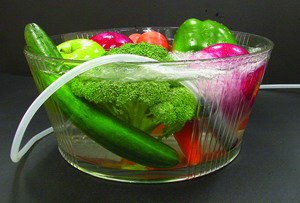The Danger of Food with High Doses Of Pesticides

EPA Study: Week of Organics Cleans Pesticides from Kids' Blood
A new EPA study fed 23 Seattle children an all-organic diet for a week and saw the pesticide levels in their blood drop to virtually zero. As soon as the kids started back on their conventional diets, their pesticide levels rocketed back up. The study, published in Environmental Health Perspectives, focused on agricultural rather than household and lawn pesticides, but does show conclusively that, as Grist puts it, "pesticide-free food leads to pesticide-free kids." And since exposure to pesticides can cause birth defects and other developmental problems in children, this one definitely puts another feather in organics' cap.
Pesticides in Produce
Adjusting your eating habits can lower your intake of pesticides -- sometimes dramatically so. Substitute organic for conventional produce that is consistently contaminated with pesticides. When organic is not available, eat fruits and vegetables with consistently low pesticide loads.
An EWG simulation of thousands of consumers eating high and low pesticide diets shows that people can lower their pesticide exposure by 90 percent by avoiding the top twelve most contaminated fruits and vegetables and eating the least contaminated instead.
Eating the 12 most contaminated fruits and vegetables will expose a person to nearly 20 pesticides per day, on average. Eating the 12 least contaminated will expose a person to a fraction over 2 pesticides per day. Less dramatic comparisons will produce less dramatic reductions, but without doubt using the Guide provides people with a way to make choices that lower pesticide exposure in the diet.
Most Contaminated: The Dirty Dozen
Consistent with two previous EWG investigations, fruits topped the list of the consistently most contaminated fruits and vegetables, with eight of the 12 most contaminated foods. Among the top six were four fruits, with peaches leading the list, then strawberries, apples and nectarines. Pears, cherries, red raspberries, and imported grapes were the other four fruits in the top 12.
Among these eight fruits: Nectarines had the highest percentage of samples test positive for pesticides (97.3 percent), followed by pears (94.4 percent) and peaches (93.7 percent).
Nectarines also had the highest likelihood of multiple pesticides on a single sample — 85.3 percent had two or more pesticide residues — followed by peaches (79.9 percent) and cherries (75.8 percent).
Peaches and raspberries had the most pesticides detected on a single sample with nine pesticides on a single sample, followed by strawberries and apples, where eight pesticides were found on a single sample.
Peaches had the most pesticides overall with some combination of up to 45 pesticides found on the samples tested, followed by raspberries with 39 pesticides and apples and strawberries, both with 36.
Spinach, celery, potatoes, and sweet bell peppers are the vegetables most likely to expose consumers to pesticides.
Among these four vegetables: Celery had the highest of percentage of samples test positive for pesticides (94.5 percent), followed by spinach (83.4 percent) and potatoes (79.3 percent). Celery also had the highest likelihood of multiple pesticides on a single vegetable (78 percent of samples), followed by spinach (51.8 percent) and sweet bell peppers (48.5 percent).
Spinach was the vegetable with the most pesticides detected on a single sample (10 found on one sample), followed by celery and sweet bell peppers (both with nine).
Sweet bell peppers were the vegetable with the most pesticides overall with 39, followed by spinach at 36 and celery and potatoes, both with 29.
Least Contaminated: Consistently Clean
The vegetables least likely to have pesticides on them are sweet corn, avocado, cauliflower, asparagus, onions, peas and broccoli.
Nearly three-quarters (73 percent) of the pea and broccoli samples had no detectable pesticides. Among the other vegetables on the least-contaminated list, there were no detectable residues on 90 percent or more of the samples.
Multiple pesticide residues are extremely rare on any of these least contaminated vegetables. Broccoli had the highest likelihood, with a 2.6 percent chance of more than one pesticide when ready to eat. Avocado and corn both had the lowest chance with zero samples containing more than one pesticide when eaten.
The greatest number of pesticides detected on a single sample of any of these low-pesticide vegetables was three as compared to 10 found on spinach, the most contaminated crop with the most residues. Broccoli and onions both had the most pesticides found on a single vegetable crop at up to 17 pesticides but far fewer than the most contaminated vegetable, sweet bell peppers, on which 39 were found.
The five fruits least likely to have pesticide residues on them are pineapples, mangoes, bananas, kiwi and papaya.
Fewer than 10 percent of pineapple and mango samples had detectable pesticides on them and fewer than one percent of samples had more than one pesticide residue. Though 53 percent of bananas had detectable pesticides, multiple residues are rare with only 4.7 percent of samples containing more than one residue. Kiwi and papaya had residues on 23.6 percent and 21.7 percent of samples, respectively, and just 10.4 percent and 5.6 percent of samples, respectively, had multiple pesticide residues.
Highest in Pesticides
These 12 popular fresh fruits and vegetables are consistently the most contaminated with pesticides.
• Apples• Bell Peppers• Celery• Cherries• Grapes (imported)• Nectarines• Peaches• Pears• Potatoes• Red Raspberries• Spinach• Strawberries
Lowest in Pesticides
These 12 popular fresh fruits and vegetables consistently have the lowest levels of pesticides.
• Asparagus• Avocados• Bananas• Broccoli• Cauliflower• Corn (sweet)• Kiwi• Mangos• Onions• Papaya• Pineapples• Peas (sweet)

0 Comments:
Post a Comment
<< Home